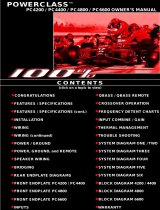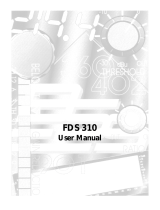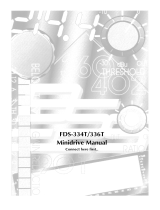
1 170.929UK, 170.932UK User Manual
CX23, CX34
ACTIVE CROSSOVERS
Order ref: 170.929UK, 170.932UK
User Manual

2 170.929UK, 170.932UK User Manual
Introduction
Thank you for choosing a Citronic active crossover. This product has been designed to give accurate
control for a multi-amplifier sound reinforcement system. In order to achieve the best results from
this equipment and avoid damage through misuse, please read and follow these instructions and
retain for future reference.
Warning
To prevent the risk of fire or electric shock, do not expose any part of the unit to rain or moisture.
If liquids are spilled on the surface, stop using immediately, allow unit to dry out and have checked
by qualified personnel before further use.
Avoid impact, extreme pressure or heavy vibration to the unit.
There are no user serviceable parts inside the crossover – refer all servicing to qualified service
personnel.
Safety
Check that the supplied mains lead is in good condition and the supply voltage is correct.
Ensure signal leads are of good condition and connected to appropriate inputs/outputs
Do not allow any foreign particles to enter the console through control apertures or connector
apertures
Placement
Keep out of direct sunlight and away from heat sources.
Keep away from damp or dusty environments.
When rack-mounting, avoid placing heavy units above the unit and ensure all connectors are
accessible
Cleaning
Use a soft cloth with a neutral detergent to clean the casing as required
Use a soft brush to clear debris from the control surface
Do not use strong solvents for cleaning the unit.

3 170.929UK, 170.932UK User Manual
Front Panel
Rear Panel
14. Low Cut filter: Channel B
15. Low/High - Mid/High crossover Frequency: Channel B
16. Low/High - Low/Mid crossover Frequency: Channel B
17. Low or Mid output gain: Channel B
18. Mid/High - High-mid/High crossover frequency: Ch B
19. Low or Mid output phase switch: Channel B
20. Low output gain: Channel B
21. Low output phase switch: Channel B
22. Mid or High-mid output gain: Channel B
23. Mid or High-mid output phase switch: Channel B
24. High output gain: Channel B
25. High output phase switch: Channel B
26. Power switch
1. Input gain: Channel A
2. Low Cut filter: Channel A
3. Low/High X-over Frequency: Channel A
4. Low/High - Low/Mid crossover Frequency: Channel A
5. Low/Mid - Mid/High crossover Frequency: Channel A
6. Low output gain: Channel A
7. Low output phase switch: Channel A
8. Mid or Low-mid output gain: Channel A
9. Mid or Low-mid output phase switch: Channel A
10. High output gain: Channel A
11. High output phase switch: Channel A
12. Mono/Stereo mode indicators
13. Input gain: Channel B
27. Voltage selector
28. IEC mains inlet
29. High output: Channel B
30. High-mid or Mid output: Channel B
31. Low or Mid output: Channel B
32. Low output: Channel B
33. Crossover frequency multiplier: Channel B
34. Input: Channel B
35. Mode selector buttons
36. Mono Normal/Summed switch
37. High output: Channel A
38. Low-mid or Mid output: Channel A
39. Low output: Channel A (or LF Sum both channels)
40. Crossover frequency multiplier: Channel A
41. Input: Channel A

4 170.929UK, 170.932UK User Manual
What is an Active Crossover?
A crossover is a device for separating the high frequencies from the low frequencies in a sound
reinforcement system. Passive crossovers exist in speaker cabinets to split the high and low
frequencies of an amplifier output and feed into the appropriate speaker components.
This is usually necessary in cabinets with separate low frequency and high frequency speaker
components (woofers and tweeters) but can be inefficient because it operates on the high energy
output from an amplifier and dissipates much energy as heat.
Active crossovers operate
before
the amplifier(s) stage, where the signal is typically less than a Volt,
affording accurate and efficient separation of the component frequencies. Essentially, an active
crossover splits each audio signal into 2, 3 or even 4 sets of frequencies, feeding each into a
separate amplifier, which in turn powers a specific speaker component.
This allows each speaker component to handle just the type of sound it produces most efficiently,
avoiding wasting energy from the amplifier.
Configuration
The CX23 can be configured as a 2-way stereo or 3-way mono crossover
The CX34 can be configured as a 2-way stereo, 3-way stereo or 4-way mono crossover
The connection and operating mode depends upon the type of amplifier configuration (bi-amp, tri-
amp or quad-amp)

5 170.929UK, 170.932UK User Manual
Connection
In all configurations, the output(s) (left and right or mono) from the signal source (usually the main mixing
console) are connected to the input(s) of the crossover. All connections are balanced (or unbalanced, if
preferred) and should be connected using good quality XLR leads.
In a bi-amped system, the LOW (or LF SUM) outputs are connected to the inputs of the power amplifier which
will drive the sub cabinets and the HIGH outputs are connected to the inputs of the power amplifier which will
drive the mid-top cabinets.
In a tri-amped system, the LOW (or LF SUM) outputs are connected to the inputs of the power amplifier which
will drive the sub cabinets, the MID outputs are connected to the power amplifier which will power the main
drivers of the mid-top cabinets and the HIGH outputs are connected to the inputs of the power amplifier
which will drive the high frequency drivers in the mid-top cabinets.
In a quad-amped system, the LOW (or LF SUM) output is connected to the input of the power amplifier which
will drive the sub cabinets, the LOW-MID output is connected to the power amplifier which will power the
dedicated mid-range cabinets, the HIGH-MID outputs are connected to the power amplifier which will power
the main drivers of the mid-top cabinets and the HIGH outputs are connected to the inputs of the power
amplifier which will drive the high frequency drivers in the mid-top cabinets
Operation
Connect the crossover to mains power via the supplied IEC lead, ensuring the supply voltage is correct. There
may be slight variations from these set-ups but all follow the same basic principles.
It may help to know the frequency responses of all speaker components in the system or alternatively,
crossover setup can be done by ear. The main parameters are the crossover frequencies and gain amounts for
each output. Select the MODE that the crossover is to be used from the buttons on the rear panel. Each mode
gives controls different parameters, so care must be taken to read the control’s function printed on the front
panel for the given mode. If tri-amped or quad-amped systems are used, the Crossover frequency multiplier
should be pressed in for MID/HIGH or HIGH-MID/HIGH crossover points. This causes the frequency control to
operate at a much higher frequency (10x) which is more suited to the division between mid and high drivers.
With all amplifiers switched off, turn down all GAIN controls and switch on the crossover. Switch on amplifiers
and turn up the volume of each output. Play the signal from the sound source (mixer) through the crossover
and gradually increase the gain controls of each section. Gradually rotate the XOVER FREQ (crossover
frequency) control for LOW/HIGH or LOW/MID or LOW/LOW-MID until the desired bass character is achieved.
This is the control that determines the highest frequencies that will be fed into the sub cabinets. Lower
crossover settings will need higher gain settings to compensate for frequencies that are
not
fed into the sub
cabinet (filtered out).
Repeat the crossover frequency setting process for LOW-MID, MID, HIGH-MID and HIGH frequencies (where
appropriate) adjusting the crossover frequencies to suit each driver and gains to balance the range of
frequencies. Occasionally, frequencies from some cabinets in stereo setups can have opposing phase
characters. Also, some drivers may sit physically further back from others. This can cause cancellation of
frequencies. To deal with this, the Citronic crossovers have Phase switches, which can be pressed in to invert
the phase of the signal (push becomes pull and vice versa). This can be tested by trial and error to hear if
pressing the switch in has a beneficial effect to the volume level of that particular frequency. To further help
avoiding phase cancellation, the LOW can be “summed” to a mono signal (LF SUM), eradicating differing
signals in the lower registers of a stereo signal.
Remember to turn down amplifiers and switch off prior to powering down the crossover to avoid loud noises
in the sound system.

6 170.929UK, 170.932UK User Manual
Specifications
Model
CX23
CX34
Power supply
115/230Vac selectable 50/60Hz (IEC)
Input impedance: balanced
40kΩ
50kΩ
Input impedance: unbalanced
20kΩ
25kΩ
Output impedance
220Ω
200Ω
Crossover ranges: stereo
50Hz-5kHz;750Hz-7.5kHz
45-960Hz (switchable 10x) or
450Hz-9.6kHz
Crossover ranges: mono
50Hz-5kHz;750Hz-7.5kHz;
2kHz-20kHz
45-960Hz (switchable 10x) or
450Hz-9.6kHz
Filter slope
18dB/octave
24dB/octave
Frequency response
20Hz-25kHz +0/-1dB
20Hz TO 20KHz, +0/-0.5dB
Signal to noise ratio
>90dB
THD
<0.006% @ +4dBu, 1KHz
<0.004% @ +4dBu, 1KHz
Dimensions
482 x 170 x 44 mm
Weight
2.5Kg
Troubleshooting
No function and Power
switch LED is not lit
Ensure mains voltage is correct (check selector) and connected properly
Ensure front panel power switch and mains outlet switch are on
Power is on but no
audio output
Check XLR leads are OK and connected properly
Check that INPUT and OUT GAIN controls are not turned fully down
Check that inputs and outputs are connected the correct way around
Check that LOW out is not connected to amp for mid-high cabs in error
Check that MID or HIGH out is not connected to amp for subs in error
Distorted output
Reduce INPUT and HIGH/MID/LOW OUT Gain controls
Lower XOVER FREQ for sub cabinets
Check frequency multiplier switches are set correctly
Output is very low
level
Check XOVER FREQ is set correctly for each output
Test phase switches of different outputs to hear if need to be inverted
Increase Gain control(s) to compensate
Errors and omissions excepted.
Copyright© 2013. AVSL Group Ltd.
-
 1
1
-
 2
2
-
 3
3
-
 4
4
-
 5
5
-
 6
6
Qtx CX23 User manual
- Category
- Home audio sets
- Type
- User manual
Ask a question and I''ll find the answer in the document
Finding information in a document is now easier with AI
Related papers
Other documents
-
Citronic CX23 User manual
-
Peavey Project V Owner's manual
-
Art Model 310 User manual
-
 Precision Power PC4200, PC4400, PC4800, PC6600 Owner's manual
Precision Power PC4200, PC4400, PC4800, PC6600 Owner's manual
-
 BSS Audio FDS-310 User manual
BSS Audio FDS-310 User manual
-
BBE DS24 and DS26 User manual
-
 BSS Audio FDS-366T User manual
BSS Audio FDS-366T User manual
-
Behringer Super-X Pro CX3400 User manual
-
 BSS Audio FDS-336T User manual
BSS Audio FDS-336T User manual
-
Samson S3-Way User manual









